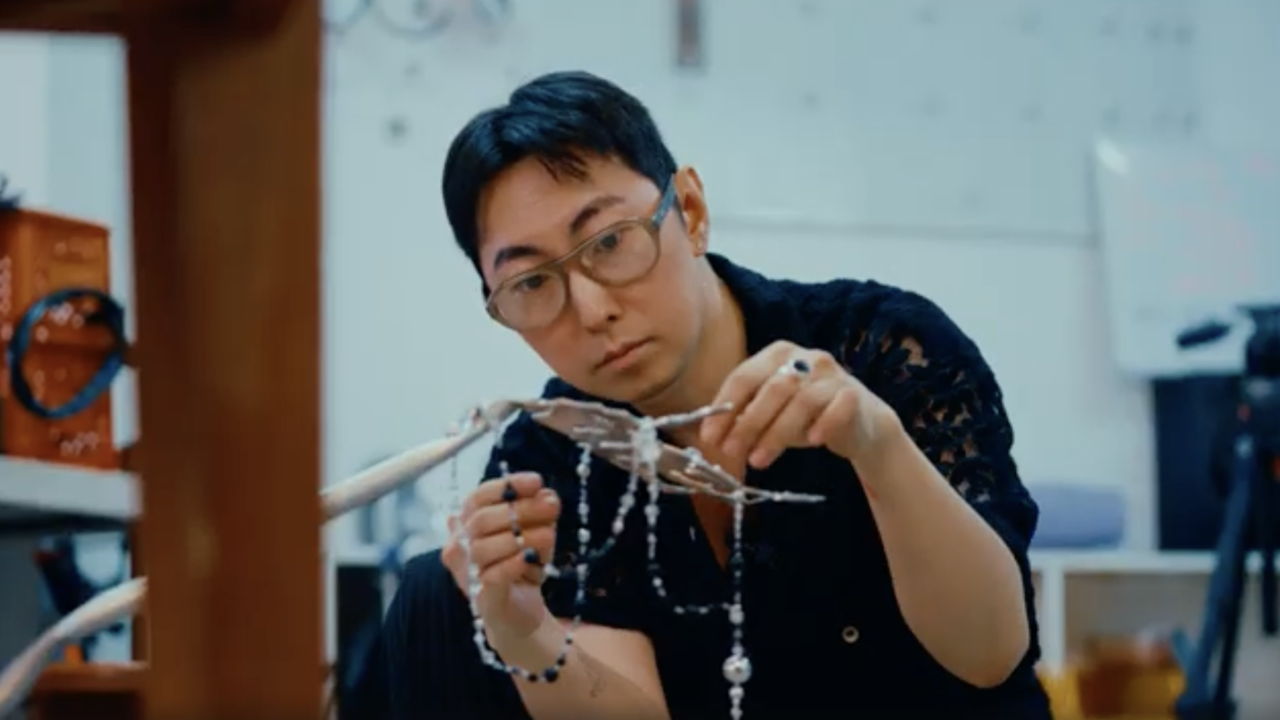Ellen Gallagher
Until Rirkrit Tiravanija rides back into town and unpacks his cooking utensils, Ellen Gallagher is the current darling of the New York art world. In these identity-and-alterity-saturated times of one penny operettas, the fact that she is not a Conceptual artist but a painter, makes this an even more interesting love affair. Take a painting like Totentanz (1995), marked out by chalky horizontal blocks of glued-down paper that resemble a brick wall, into which she has packed notions of femininity and race by incising a ghostly, looming shape that mimics a head, the curve of a woman's body and an urn or trophy, and you will understand why she's raised such a ruckus since appearing in the last Whitney Biennial.
Because innocence and joy are not appealing ingredients in the art world, and because Gallagher is an African-American woman who makes gorgeous abstract works of deceptively calm, pleasurable sea surfaces, one gets nervous. Beneath this though, lies a more discordant purpose that purportedly carries the kind of political content (read: race) and outward signs of otherness that many feel lacking in painting today. In fact, I can tell you a few things about Black artists and abstraction in the history of art in this country...
As has been suggested previously in writing on Gallagher, two icons fat-lipped minstrels and bug-eyed coons with buckwheat hair are compulsively insinuated into her work, as well as into our field of vision, less to assault us with shrill didacticism than as rueful reminders of how black pain is usually treasured material for cheap jokes by second-rate comics. In the new works, these two icons have been joined by a third: a red-lipped, blond-haired woman, a parody of a Caucasian socialite, in Oh Susannah (1995). Gallagher's employment of racist stereotypes that spawned a whole cottage industry in the entertainment revues of yore remind me of one of Carrie Mae Weems' photographic installations. In the work, Weems asks: 'What are three things you can't give a black man?', to which she answers, 'a fat lip, a black eye and a job'.
Weems' work points to another impossibility, which is the potential lack of seriousness the art world accords to the work of African-American artists unless they have some angst-driven flag, tethered to the pole of difference, to unfurl. Perhaps that's the prime reason why many people in my art orbit seem to have quickly concluded that Gallagher is being set up for a hard fall. Of course, there is no evidence of such a conspiracy, only what they refer to as 'instinct'. Instinct is usually confirmed when you discuss art in very close quarters to race in America. The odds are that critics will more likely fall silent, treating such a matter as a novelty and less as a radical manifestation of paradigmatic currency.
Such declamations notwithstanding, what makes Gallagher's work so satisfying in the end is its sophistication and her confidence in putting forward a proposition that mixes formalism with goofiness. A charmer, she seems to want to elicit laughter from her audience, despite the fact that pain accompanies her happy-go-lucky mark-making. Paintings such as Delirious Hem (1995) and Wild Kingdom (1995), both of which, in their iconographies, implicitly refer to femininity and race, have such a tender beauty. They seem ready to vanish before your very eyes, as if they were never there in the first place. Each work is laid out by carefully gluing down, across the expanse of fairly large canvases, reams of ruled note paper torn from the pages of a schoolbook. In Elephant Bones (1995) they form a grid of continuous, repeating bands of faint blue lines that are sometimes interspersed and supplemented by her own irregular dotted lines. This gives a feeling of topography, only instead of landscape, she incises minute coffee-bean shaped figures that trail off like ant shit. Those in the know say these shapes represent mouths or something of that kind. I must confess, it wasn't evident to me when I last looked at the piece.
Acknowledging her obvious debt to Agnes Martin, Gallagher takes Martin's humane, less distancing Minimalism, with its unaffected, spare, undulating bareness and intense radiance, and supplants it by inflecting her own reading of Minimalism with a topical irony and wit. DY-NO-mite (1995), which refers to the insouciant exclamations of a popular character in the 70s sitcom Good Times, evinces this radical humour and wide-awakeness to social and cultural history which Minimalism seemed incapable of.
Gallagher's sexy, lean and muscular paintings are truly accomplished. If the history which her work tackles often fails to register, it is only because it has been rendered almost microscopically and obliquely a savvy move. In fact, the best way to see why her paintings have caused such a brouhaha is to get very close to them, magnifying glass in hand. Only then will you begin to see in precise detail the atlas that makes up the cultural and historical landscape she is cataloguing and unpacking on the site of abstraction. The affinity to mapping (which in some sense reminds me of Guillermo Kuitca's work) reveals a process whereby cultural totems are abstractly and faintly delineated for heightened effect, bringing her work quite close to the whispery conditions of today.
















